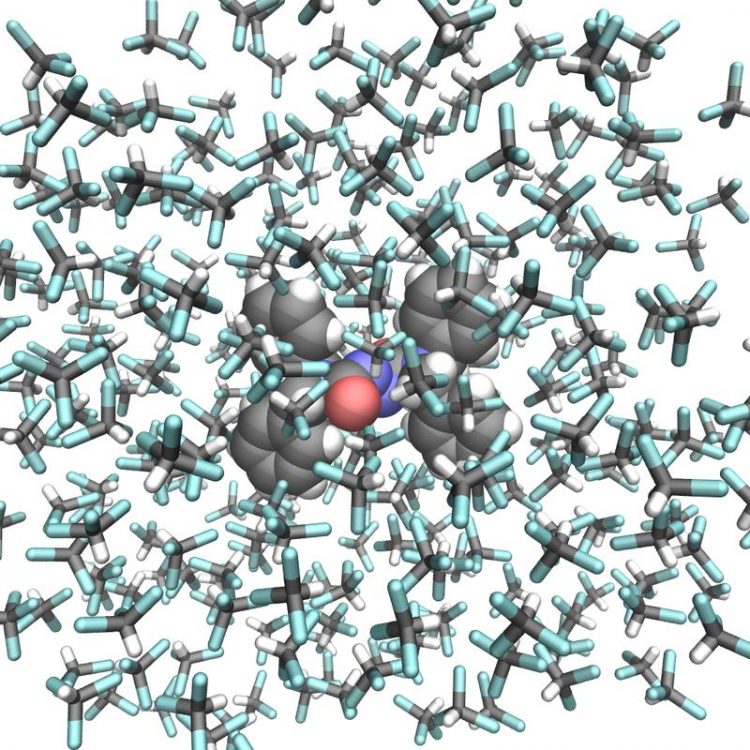Researchers create a photographic film of a molecular switch

Molecular structure of the photo-responsive molecular switch (center) surrounded by solvent molecules. The scientists revealed a light-induced pedalo-type motion. The image is on the cover of the recent print edition of the journal. I. Conti et al.(2020),TJPCL,ACS
Molecular switches – they are the molecular counterparts of electrical switches and play an important role in many processes in nature. Such molecules can reversibly interconvert between two or more states and thereby control molecular processes.
In living organisms, for example, they play a role in muscle contraction but also our visual perception is based on the dynamics of a molecular switch in the eye.
Scientists are working intensively to develop novel molecular components that enable switching between different states, so that molecular processes can be specifically controlled.
A European research team led by nanotechnologist Dr. Saeed Amirjalayer from the University of Münster now gained a deeper insight into the processes of a molecular switch: Using molecular dynamics simulations, the scientists produced a photographic film at the atomic level and thus tracked the motion of a molecular building block.
The result was a light-controlled “pedalo-type motion”, going forward and backward. Although it had already been predicted in this context in earlier work, it could not be directly proven so far.
In the future, the results may help to control the properties of materials with the help of molecular switches – for example, in order to release drugs specifically from nano-capsules.
“For efficient embedding in novel responsive materials, detailed elucidation of the switching process and thus the way they function at the molecular and atomic level is crucial,” emphasizes Dr. Saeed Amirjalayer, group leader at the Institute of Physics at Münster University and the Center for Nanotechnology (CeNTech). The study has been published in the “The Journal of Physical Chemistry Letters”.
Background and methods:
Molecular dynamics simulations enable, by calculating the interactions between atoms and molecules, to describe their motion in the computer. In their current study, the scientists investigated an azodicarboxamide-based molecular switch in this way, using a so-called combined quantum mechanical/molecular mechanical method in the simulations.
“Previous experimental and theoretical studies provided only an indirect insight into the operation mechanism of such a switch in solution. With the help of our theoretical approach, we could now follow the light-induced dynamics while taking the molecular environment into account,” explains Saeed Amirjalayer.
The pedalo-type motion of the switch, triggered by light, moves backward and forward – like a bicycle pedal. Detailed understanding of the operation mechanism of a photo-responsive switch forms an important basis for the application of these molecular building blocks in novel “intelligent” functional materials.
In addition to the University of Münster, the Universities of Bologna (Italy) and Amsterdam (Netherlands) were involved in the study. “Despite the current circumstances in the wake of the Corona crisis, the cross-border exchange with colleagues from Europe could take place – virtually, but still very intensively. Together we achieved interesting and valuable results,” says Saeed Amirjalayer summing up the cooperation.
Funding:
This work was supported by German Research Foundation (DFG) and The Netherlands Organization for Scientific Research (NWO).
Dr. Saeed Amirjalayer (University of Münster)
Email: s.amirjalayer@wwu.de
Fon: +49 (0)251 83 63919
http://www.samirjalayer.de
I. Conti et al. (2020): Photoinduced Forward and Backward Pedalo-Type Motion of a Molecular Switch. The Journal of Physical Chemistry Letters; DOI: 10.1021/acs.jpclett.0c01094
https://pubs.acs.org/doi/full/10.1021/acs.jpclett.0c01094 Original publication in “The Journal of Physical Chemistry Letters”
https://www.samirjalayer.de/ Research group “Stimuli-Responsive Nanomaterials Group” at Münster University
https://www.uni-muenster.de/forschung/profil/schwerpunkt/nanowissenschaften.html Research focus “Nanosciences” at Münster University
Media Contact
All latest news from the category: Life Sciences and Chemistry
Articles and reports from the Life Sciences and chemistry area deal with applied and basic research into modern biology, chemistry and human medicine.
Valuable information can be found on a range of life sciences fields including bacteriology, biochemistry, bionics, bioinformatics, biophysics, biotechnology, genetics, geobotany, human biology, marine biology, microbiology, molecular biology, cellular biology, zoology, bioinorganic chemistry, microchemistry and environmental chemistry.
Newest articles

Properties of new materials for microchips
… can now be measured well. Reseachers of Delft University of Technology demonstrated measuring performance properties of ultrathin silicon membranes. Making ever smaller and more powerful chips requires new ultrathin…

Floating solar’s potential
… to support sustainable development by addressing climate, water, and energy goals holistically. A new study published this week in Nature Energy raises the potential for floating solar photovoltaics (FPV)…

Skyrmions move at record speeds
… a step towards the computing of the future. An international research team led by scientists from the CNRS1 has discovered that the magnetic nanobubbles2 known as skyrmions can be…





















